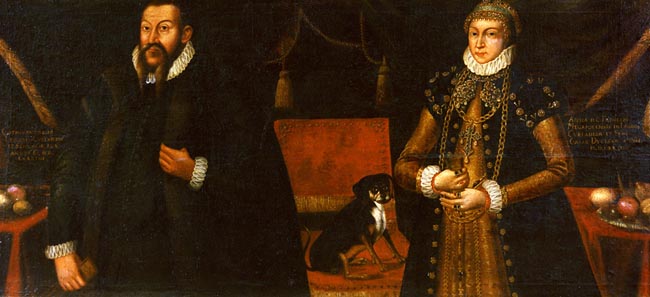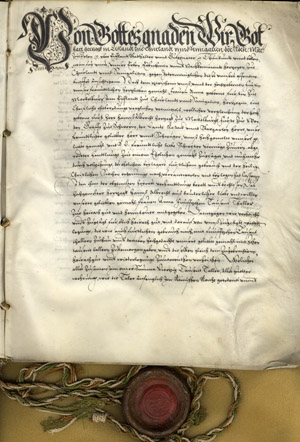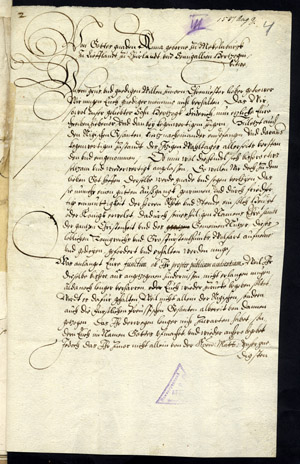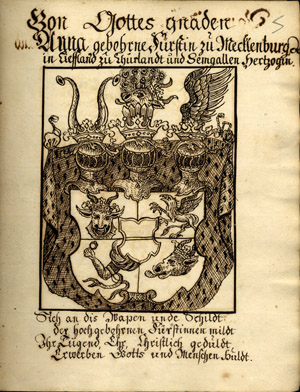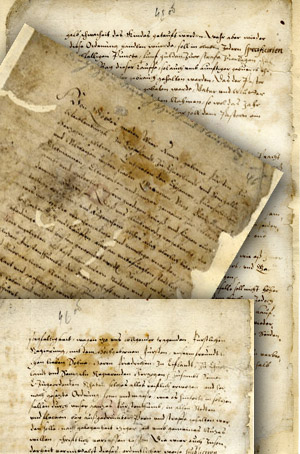Duchess Anna (15331602)
Ensuring the future of the dynasty was crucial for the continued existence of the Duchy of Courland. Although Gotthard Kettler had conducted negotiations on marriage to Anna, the daughter of Albrecht VII, Duke of Mecklenburg (14861547), already since 1563, they were married only in March 1566 in Königsberg. This was chosen as the venue for the wedding because the bride's mother, also named Anna (15071567), came from the branch of the Hohenzollern family to which the Elector of Brandenburg also belonged, and her brother Johann Albrecht (15251576), who ruled Mecklenburg at the time, was married to the daughter of the Duke of Prussia. After marriage celebrations lasting two weeks, the newly-weds travelled to Goldingen/Kuldīga, accompanied by envoys from Prussia and Mecklenburg, and here the celebrations continued. They had five sons and two daughters, but three of the sons died in childhood. There is relatively little preserved evidence of the activities of Duchess Anna, but it is clear that she not only took care of the family, but also actively assisted her husband in many of his undertakings. After Gotthard's death Anna continued to play a role in the administration of the duchy, supporting her son Frederick. Anna was also capable in managing her manors and was able to obtain a good income from them. While Gotthard was still alive, she re-purchased the manors of Talsen/Talsi, Annenburg/Emburga and Misshof/Misa, which had been granted as fiefs during the time of the order. In September 1590 Anna accompanied her younger son William to Königsberg, part of the way to Rostock, where he was to study. In early 1592 and again in the summer of 1598 she visited her relatives in Mecklenburg and obtained possession of the manor of Osten in Western Pomerania, near the town of Loitz, as a mortgaged property. This manor still belonged to the Dukes of Courland in the late 17th century. Duchess Anna died on 4 July 1602, and was buried on 24 October next to her husband in the vault of Mitau/Jelgava Castle.
1. Double portrait of Duke Gotthard of Courland and Duchess Anna. Artist unknown. 1584. Original in a private collection in Germany. Photo from the collections of Rundāle Palace Museum.
2. Marriage agreement signed by Duke Gotthard. Königsberg, 21 March 1566. Parchment. LVVA, Collection 554, Inventory 1, File 19.
The marriage agreement entitled Anna to the income from manors Kaldenhof/Viskaļi, Bergfriedt/Svirlauka, Sessau/Sesava, Grünhof/ Zaļenieki, Grenzhof/Mežmuiža (present-day Augstkalne), as well as the castles and manors of Mitau/Jelgava and Neuburg/Jaunpils. Altogether, they had to give the duchess an annual income of at least 4000 thalers. On these properties Anna enjoyed supreme and lower judicial authority. The five-page agreement also lists all the landowners 19 in total who were to give vassal service to the duchess. The manors mentioned in the marriage agreement also constitute the duchess' dower. However, Anna was forced to give up Neuburg/Jaunpils in 1576, when a several-years-long conflict between Duke Gotthard and the former Commander of Doblen/Dobele Thiess von der Recke was resolved and Neuburg/Jaunpils was recognised as the property of Recke, while Doblen/Dobele as the property of the duke.
3. Letter from Anna to Samuel von Wolpen, the envoy of Courland in Warsaw, a councillor and later chancellor. Mitau/Jelgava, 9 August 1587. LVVA, Collection 554, Inventory 1, File 51a.
The letter illustrates the participation by the duchess in matters of state. Wolpen had previously reported that he had not been able to secure an official audience in the Polish court, and so Anna ordered the envoy to return from Warsaw to Courland, especially since the envoys of Prussia and Riga had already departed. However, before leaving, Wolpen was to pay private visit to the queen and the officials, in order to remind them in informal discussion of issues important to the duchess.
4. Coat of arms of Duchess Anna. Drawing from a code of Church laws of the Duchy of Courland, 1570. LVVA, Collection 4038, Inventory 2, File 930.
Even as Duchess of Courland, Anna retained the arms of her native Mecklenburg. The arms of Mecklenburg are to be seen on the seals she used and on her sarcophagus in the vault of Mitau/Jelgava Castle.
5. Regulation on celebrations and dress, issued by Anna. [Mitau/Jelgava, 23 February 1591]. Copy, turn of the 17th century. LVVA, Collection 554, Inventory 3, File 1837.
Regulations intended to curb excessive spending and extravagance are known in Europe already since the Middle Ages. They also fitted the Early Modern concept of the state, with social disciplining of society and a clear division into estates. The regulations issued by Duchess Anna represent the oldest such document so far known that relates to the Duchy of Courland. Although in the preamble Anna expresses her dissatisfaction with the extravagant lifestyle of the population of Mitau/Jelgava, the regulations applied to the residents of all towns and townships in the duchy. Issue of the regulations is motivated not only by moral, but also by pragmatic considerations, because opulence and excess are seen as giving rise to unnecessary expense, which leads to ruin. The regulations consist of two parts. The first part regulates betrothal, wedding and christening celebrations. Betrothal was permitted in a church, in the courtyard of a church, or in “the home of honest people” in the presence of witnesses. If a feast was held at the house of the fiancée, no more than 10 guests were to attend, and no more than 3 dishes were to be served, not including cheese and butter. The number of wedding guests was limited to 60 for the wedding of a town councillor, 40 for a merchant, 30 for a craftsman and 20 for a simple servant. Weddings were to take place on Mondays, and the couple had to arrive in church no later than 11 o’clock, otherwise no wedding could be held that day. The wedding celebrations were to take place between 12 midday and 9 in the evening in summer, or 8 in the evening in winter, and it was prohibited to continue celebrating the next day. The number of courses at the meal was also limited to 34. Wine and mead could only be given at the weddings of town councillors. No celebrations were permitted at christenings. A child had to be christened in 8 days time in church, and christening at home was only permitted if the child was too weak. The second part of the regulations brought together restrictions on dress. Thus, no town-dweller, even town councillors, could wear dress made of velvet or satin. Only town councillors could wear silk and damask. Jewellery was also regulated. Women were forbidden to wear gold bracelets and chains, and only the wives of the highest officials could wear a gold chain around the neck, with a maximum of twenty links. Also, all the wives of town citizens were prohibited from wearing dress fitting for foreigners or the nobility. Infringements of the regulation were punishable by fines and confiscation of the finery.